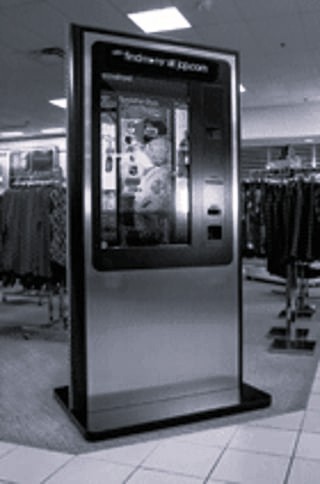
The Challenge
JCPenney introduced in-store digital shopping tool—the findmore interactive kiosk—to bridge the gap between in-store and online assortments. It allowed customers to browse the full product range, email or print selections, and explore items not physically available in the store.
Before rolling out to more locations, leadership wanted to understand customers’ expectations of the technology, as well as how it could be optimized to truly enhance the shopping experience.
Approach
To evaluate and improve the findmore experience, I led a multi-method research effort across four store locations.
The goal was to uncover customer expectations, identify usability pain points, and provide actionable guidance for refining the product experience. The approach taken was cognizant of limited time and resources, while leveraging the internal team’s expansive skillset.
Methods included:
- Customer Experience Interviews with 98 intercepted in-store shoppers using think-aloud protocols
- Video Observations to assess approachability, hesitation, and traffic patterns (leveraged security surveillance video)
- Employee Interviews with 14 store associates to gather frontline insights based on their customer engagement and observation
- Behavioral Analytics Review of the kiosk (e.g., search terms, sessions, actions)
- Post-Usage Survey leveraging kiosk receipt as invitation source (limited results due to low response)
This holistic mix of qualitative and quantitative data gave us a full picture of how the kiosk was (and wasn’t) meeting user needs.
Output
The research culminated in a comprehensive insights report and strategic recommendations tailored for cross-functional stakeholders, including UX, product, and store operations teams.
- Synthesis of Customer Expectations vs. Experience
A clear comparison of what customers assumed the kiosk would do versus how it functioned in practice, highlighting areas where expectation gaps affected engagement. - User Journey & Interaction Themes
Mapped the in-store digital interaction journey, surfacing common patterns in user behavior, confusion points, and emotional highs and lows during the experience. - Cross-Channel Experience Insights
Identified broader issues in the connection between in-store and digital shopping experiences, with implications for messaging, product visibility, and channel alignment. - Usability & Access Recommendations
Provided guidance for improving physical and digital usability—based on real customer behavior—without compromising the existing retail environment or operations model.
All deliverables were designed to support future decision-making while respecting the pilot’s sensitive data, with options for both near-term improvements and longer-term experience design strategy.
Impact
- Informed UX redesign priorities and usability enhancements
- Guided store operations on better positioning and signage for the kiosk
- Raised awareness of in-store vs. digital pricing discrepancies and expectation mismatches
- Prompted review of hardware screen size, button placement, and orientation to improve physical accessibility
- Influenced a redesign of the attract loop to clarify the kiosk’s purpose vs. looking to be a store ad
- It also helped clarify the kiosk’s role within the larger in-store ecosystem, aligning product, operations, and UX teams around customer-centered decision-making

Why this Project Is Unique
The need to balance the perspectives of diverse users and stakeholders (e.g., customers, store associates, and operational teams), within a real-world, physical retail environment.
This work required bridging physical and digital experiences, evaluating not just interface usability, but also physical ergonomics, environmental context, and how in-store touchpoints influenced customer perception and behavior.
The findings extended beyond traditional UX, influencing decisions pertaining to store layout, associate workflows, and future hardware considerations.
Conducting research in a live retail setting required real-time adaptability, such as navigating unpredictable foot traffic, technical glitches, and shifting store conditions while maintaining methodological rigor.
Photo by Mikhail Nilov: https://www.pexels.com/photo/food-italian-pizza-restaurant-6969975/
